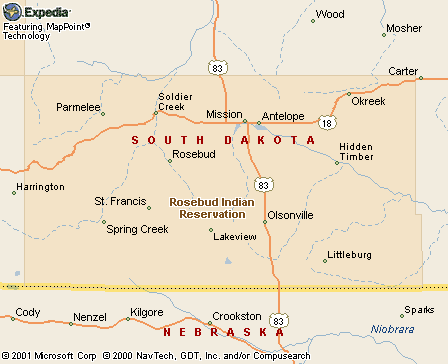|
|
Canku Ota |
|
|
(Many Paths) |
||
|
An Online Newsletter Celebrating Native America |
||
|
January 24, 2004 - Issue 105 |
||
|
|
||
|
Ferrets going to reservation |
||
|
by Jomay Steen, Rapid
City (SD) Journal Staff Writer
|
||
|
credits: Black-footed
ferret. Image courtesy of the Centers for Disease Control.
|
|
Looking for the green-eyed, reflective shine of the black-footed ferret, the director of Prairie Wildlife Research and U.S. Forest Service personnel will be setting traps. Since the animals are nocturnal, the trapping expedition will begin after 9 p.m. and finish by sunrise the next morning in the Conata Basin near Wall, Livieri said. "I've been doing this for eight to nine years; and, I'm more comfortable working at night than in the daytime," he said. On Tuesday, 30 minutes from downtown Rosebud, the Rosebud Sioux Tribe Game, Fish & Park Service will introduce the captured ferrets onto the reservation. "We plan on releasing about a dozen of them, give or take a few," Greg Jackson said. Jackson, a biologist with the Rosebud Sioux Tribe's Game, Fish and Park Service, has worked with the U.S. Fish and Wildlife Service to create a haven for the ferrets. "We have an area of prairie dogs on about 10,000 acres set aside for the ferret habitat," Jackson said. Prairie Wildlife Research is a non-profit corporation, headquartered in Wall, which conducts research and works to conserve wildlife species of the prairie and their associated habitats. PWR works with federal and state agencies, universities, private landowners, and other non-governmental organizations. The animals will be left to thrive on their own. But the wildlife officials will watch how well the animals take to their new surroundings. The kits Livieri wants to capture were born in July 2003. "They will be the young of the year, we have them marked," he said. Using scanners, they can determine the age and other information about the animal. "They've done phenomenally well here," Livieri said. The Conata Basin has a standing population of 275 black-footed ferrets. Livieri has high expectations for the Rosebud release. At one time thought to be extinct, ferret populations have increased through conservation efforts to protect the creatures. The turning point came about 13 years ago when a officials discovered a colony near Meeteetse, Wyo. A ranch dog brought a carcass to his owner. Unable to identify the animal, the man took it to a taxidermist who identified it, Livieri said. "There are only 500 total in the wild, they're extremely rare," he said. Prairie Wildlife Research has reintroduced ferret colonies in Montana, Wyoming, Arizona and Mexico. Contact Jomay Steen at 394-8418 or jomay.steen@rapidcityjournal.com. |
|
|
www.expedia.com |
|
|
||
|
|
||
| Canku Ota is a free Newsletter celebrating Native America, its traditions and accomplishments . We do not provide subscriber or visitor names to anyone. Some articles presented in Canku Ota may contain copyright material. We have received appropriate permissions for republishing any articles. Material appearing here is distributed without profit or monetary gain to those who have expressed an interest. This is in accordance with Title 17 U.S.C. Section 107. | ||
|
Canku Ota is a copyright © 2000, 2001, 2002, 2003, 2004 of Vicki Lockard and Paul Barry. |
||
 |
 |
|
|
The "Canku Ota - A Newsletter Celebrating Native America" web site and its design is the |
||
|
Copyright © 1999, 2000, 2001, 2002, 2003, 2004 of Paul C. Barry. |
||
|
All Rights Reserved. |
||
 ROSEBUD
— Between dusk and dawn today and Monday, Travis Livieri will
spotlight some of the rarest species of mammals in South Dakota.
ROSEBUD
— Between dusk and dawn today and Monday, Travis Livieri will
spotlight some of the rarest species of mammals in South Dakota.
